Inverse Electron Demand Diels–Alder Reactions of 1,2,4,5-Tetrazines and 1,2,3-Triazines
Introduction
The inverse electron demand Diels-Alder reactions of electron-deficient heterocycles are significant cycloaddition reactions for the total synthesis of natural products containing highly substituted and functionalized heteroaromatic ring systems. In collaboration with Professor Dale Boger, we are pleased to offer classes of reactive substrates that participate in inverse electron demand Diels-Alder reactions,1–11 here highlighting 1,2,4,5-tetrazines and 1,2,3-triazines.1–8 Through the total synthesis of various natural products, Boger and coworkers have showcased the effectiveness of these products to contribute to the growing pool of accessible heterocyclic ring systems.1–3 More recently, such inverse electron demand cycloaddition reactions with strained olefins or alkynes have also found widespread use in bioorthogonal conjugation studies.12–13
Explore the Diels-Alder reaction.

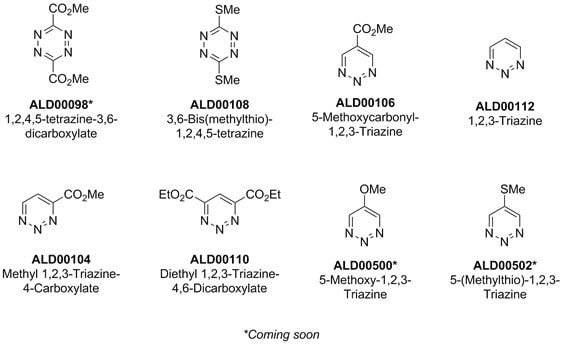
Advantages
- Useful in the synthesis of assorted heterocyclic ring systems
- Widely accessible
- Reactive with amidines, ynamines, and enamines in a regiospecific manner
- Mild reaction conditions
- [4+2] cycloadducts amendable to subsequent diversification and generation of libraries of compounds
- Bioorthogonal conjugation applications
Representative Applications
1,2,4,5-Tetrazines
Two of the most widely used symmetrical tetrazines4 for well-established [4+2] cycloaddition reactions that yield 1,2-diazine Diels–Alder products are available in our catalog: 1,2,4,5-tetrazine-3,6-dicarboxylate (ALD00098) and 3,6-bis(methylthio)-1,2,4,5-tetrazine (ALD00108).
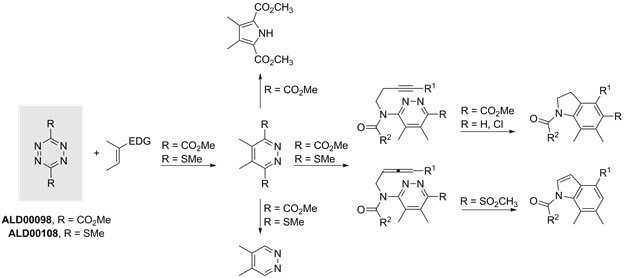
Dimethyl 1,2,4,5-tetrazine-3,6-dicarboxylate (ALD00098) is a highly reactive heteroaromatic azadiene that reacts with nearly any dienophile or heterodienophile for various applications in cycloadditions and ring-system syntheses. Albeit indirect, produced [4+2] cycloadducts are also precursors to the alkyne 1,2-diazines.5 As such, 1,2,4,5-tetrazine-3,6-dicarboxylate has found wide use in the total synthesis of natural products, such as ningalin D and purpurone.1 One abbreviated example is shown below where a 1,2,4,5-tetrazine à 1,2-diazine à pyrrole Diels–Alder strategy using an acetylenic dienophile successfully yielded lycogarubin C and lycogalic acid.2

Similar to above, 3,6-bis(methylthio)-1,2,4,5-tetrazine (ALD00108) reacts distinctly with electron-rich alkenes and alkynes. Here, the resulting 3,6-bis(methylthio)-1,2-diazine cycloadducts are immediate precursors to the parent 4,5-substituted 1,2-diazines as well as direct precursors to alkyne/allene 1,2-diazines, allowing for successive intramolecular Diels–Alder reactions.2
Comparing these two products, 1,2,4,5-tetrazine-3,6-dicarboxylate (ALD00098) was shown to react with electron-rich, neutral, and electron-deficient dienophiles at reaction rates greater than those observed with 3,6-bis(methylthio)-1,2,4,5-tetrazine (ALD00108).5
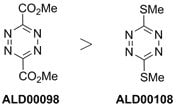
1,2,3-Triazines
1,2,3-Triazines have recently been added to this class of reagents that participate in inverse electron demand Diels-Alder reactions; they not only expand the reaction potential but also increase the access to new scaffolds by [4+2] cycloaddition. Available now to facilitate your synthesis of nitrogen-containing heterocycles: methyl 1,2,3-triazine-5-carboxylate (ALD00106), 1,2,3-Triazine (ALD00112), methyl 1,2,3-triazine-4-carboxylate (ALD00104), diethyl 1,2,3-triazine-4,6-dicarboxylate (ALD00110), 5-methoxy-1,2,3-triazine (ALD00500), and 5-(methylthio)-1,2,3-triazine (ALD00502).3,6–8
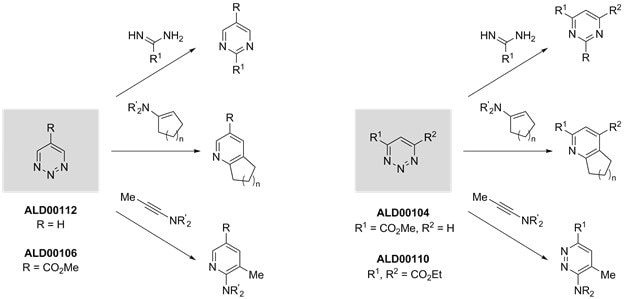
Of particular note, Boger and co-workers determined that the reactivity of the 1,2,3-triazine is modulated by the C5 substituent without relinquishing cycloaddition regioselectivity, where CO2Me (ALD00106) was much more reactive than H (ALD00112).6 Indeed, in the total synthesis of dihydrolysergic acid and dihydrolysergol, the reaction of the carbomethoxy variant (ALD00106) with enamine dienophiles at ambient temperature was not synthetically observed with the parent 1,2,3-triazine (ALD00112).3

In addition, electron-withdrawing groups at C4 and/or C6 positions (ALD00104 and ALD00110) enhanced the activity of the parent 1,2,3-triazine. Interestingly, some predictable trends in regioselectivity were observed with varied substituents.7

We also offer 1,2,3-Triazines with electron-donating substituents, 5-methoxy-1,2,3-triazine (ALD00500) and 5-(methylthio)-1,2,3-triazine (ALD00502). The methylthio derivative reacted with amidines, enamines, and ynamines; on the other hand, the methoxy analogue reacted solely with amidines.8
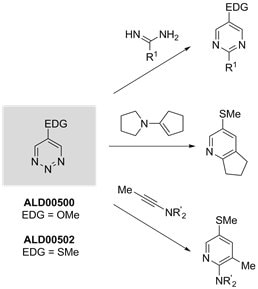
Applications in Bioconjugation
The inverse electron demand Diels–Alder reaction of 1,2,4,5-tetrazines with dienes has found widespread utility in chemical biology as a tool for bioconjugation. These copper-free, irreversible reactions have been shown to be fast, selective, and orthogonal to biological matrices where the only byproduct is dinitrogen. For example, a dienophile tethered to a biomolecule of interest can be specifically conjugated to a 1,2,4,5-tetrazine that is appended to a tag, such as a fluorescent or affinity tag, for a range of experimental objectives. We also offer 1,2,4,5-tetrazines and dienophiles suitable for the preparation of such chemical probes or bioconjugation strategies.12–13
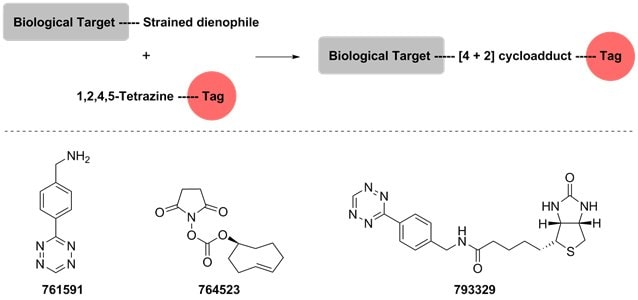
Related Definitions
Tetrazine is a class of six-ringed heteroaromatic compounds with four nitrogen atoms in the azine subgroup. Its molecular formula is C2H2N4. This class is common in click chemistry applications, especially imaging and diagnostics, because of its greater reactivity to nucleophiles and dienophiles (when compared to triazines).
Triazine is aslo a class of six-ringed organic compounds with three nitrogen atoms. Its chemical formula is C3H3N3.
References
To continue reading please sign in or create an account.
Don't Have An Account?